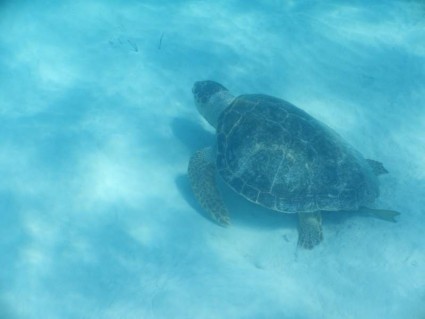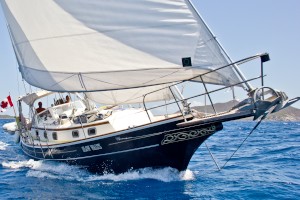
Sailing Slow Waltz
17 May 2015 | Dehaies, Guadeloupe
11 May 2015 | Nevis, WI
25 March 2015 | BVI's
25 November 2014 | Hog Island, Grenada
13 September 2014 | Mount Hartman Bay, Grenada
03 September 2014 | Mount Hartman Bay, Grenada
19 July 2014
21 June 2014 | Grenada
08 June 2014 | Chatam Bay, Union Island, SVG
25 May 2014 | Portsmouth, Dominica
25 May 2014 | Portsmouth, Dominica
13 May 2014 | St. Martin
09 April 2014 | Culebra, PR
20 March 2014 | Puerto Bahia
20 March 2014 | Samana, Dominican Republic
13 March 2014 | Puerta Plata
02 March 2014 | Turks and Caicos
10 January 2014 | Alice Town, North Bimini, The Bahamas
11 December 2013 | Vero Beach, FL
19 November 2013 | Charleston, SC
#30 - Turtles, Turtles
21 June 2014 | Grenada
Gwen

(Note: that photo is not a leatherback)
Hello from Grenada. Slow Waltz has arrived and we are settled and doing well, more to come on that later. This blog is about a turtle excursion that we attended last night. I know I am behind on blogging the rest of our trip down the leeward and windward islands to our destination of Grenada for hurricane season, but I felt this was worthy to share out of sequence.
On the north side of the island is Levera Beach where Leatherback turtles come to nest each year between February and August. The females travel from cold deep waters and come to warm tropical waters to lay 50-150 eggs every 2-3 years for their approximate 50 year lifespan. The males remain in the cold deep waters. Leatherbacks, which happened to walk the earth with the dinosaurs, are the largest of the turtles and the males can reach 2000 pounds.
The females rarely come on to the beach to lay during the day, so a night visit is required. We crowded into a local “bus” (a rather small van that manages to seat 15 close friends), 14 of us in total plus the driver and made the 90 minute drive over hills, through small villages, on less than stellar roads, and over innumerable speed bumps. We arrived at the visitor centre and received our orientation and badges and were escorted down to the beach with our tour guide. As soon as we arrived to the beach she informed us that there was a female digging her nest just in front of us. We were advised to form a semi-circle behind her to observe. And so we did. We were so close to her. Imagine you are in your living room sitting on your sofa. Now imagine that your coffee table is a 5 foot leatherback sea turtle laying 100 eggs. That’s how close we were. The researchers were taking measurements and other data. We could see her long powerful rear flippers as she dug and dug as deep as her flippers would reach before she started to lay her eggs. The guide told us that she was going to start laying and the researchers reached down and partly filled the hole she had dug under her. The guide explained that the researchers had determined that the location she had selected which would leave the nest vulnerable to the tide so they were collecting the eggs to relocate them to a safer location. So there was the researcher catching the eggs as she dropped them and putting them in bags.
We were told that the turtles are in a trance like state while they are digging and laying so our presence was not disturbing her and we were permitted to get quite close and feel her carapace (“shell”). After she finished, she began to fill the hole and really pack the sand in with her flippers. After she was happy that the hole was filled, she began to lumber herself around with her flippers to try to create the appearance of mock nests to camouflage the real location of her nest. We kept moving to stay behind her as she was doing donuts (really slow donuts), before she finally turned towards the sea and started the laborious push, despite her exhaustion to get herself back in the water where she would be able to maneuver so much easier. We came up close behind her as she pulled herself back into the sea, her black form contrasted against the white wash of the waves rolling up the shore. It was really quite moving to see her return to the sea. We were told that her female young would return to that same beach for their first nesting.
After that we saw another female coming in. Unfortunately that night there were no hatchlings to be seen. Given the 60-ish day gestation period, since they start laying in February, there are nests that start hatching in the May/June timeframe. That would have been really something too, but ah well, that’s the luck of the draw.
We crowded back into the van and made the same 90 minute drive back putting us back on the boat by 1 am. A truly late night for cruisers who generally sleep and wake with the sun, but totally worth it for a once in a lifetime experience. What a privilege.
Hello from Grenada. Slow Waltz has arrived and we are settled and doing well, more to come on that later. This blog is about a turtle excursion that we attended last night. I know I am behind on blogging the rest of our trip down the leeward and windward islands to our destination of Grenada for hurricane season, but I felt this was worthy to share out of sequence.
On the north side of the island is Levera Beach where Leatherback turtles come to nest each year between February and August. The females travel from cold deep waters and come to warm tropical waters to lay 50-150 eggs every 2-3 years for their approximate 50 year lifespan. The males remain in the cold deep waters. Leatherbacks, which happened to walk the earth with the dinosaurs, are the largest of the turtles and the males can reach 2000 pounds.
The females rarely come on to the beach to lay during the day, so a night visit is required. We crowded into a local “bus” (a rather small van that manages to seat 15 close friends), 14 of us in total plus the driver and made the 90 minute drive over hills, through small villages, on less than stellar roads, and over innumerable speed bumps. We arrived at the visitor centre and received our orientation and badges and were escorted down to the beach with our tour guide. As soon as we arrived to the beach she informed us that there was a female digging her nest just in front of us. We were advised to form a semi-circle behind her to observe. And so we did. We were so close to her. Imagine you are in your living room sitting on your sofa. Now imagine that your coffee table is a 5 foot leatherback sea turtle laying 100 eggs. That’s how close we were. The researchers were taking measurements and other data. We could see her long powerful rear flippers as she dug and dug as deep as her flippers would reach before she started to lay her eggs. The guide told us that she was going to start laying and the researchers reached down and partly filled the hole she had dug under her. The guide explained that the researchers had determined that the location she had selected which would leave the nest vulnerable to the tide so they were collecting the eggs to relocate them to a safer location. So there was the researcher catching the eggs as she dropped them and putting them in bags.
We were told that the turtles are in a trance like state while they are digging and laying so our presence was not disturbing her and we were permitted to get quite close and feel her carapace (“shell”). After she finished, she began to fill the hole and really pack the sand in with her flippers. After she was happy that the hole was filled, she began to lumber herself around with her flippers to try to create the appearance of mock nests to camouflage the real location of her nest. We kept moving to stay behind her as she was doing donuts (really slow donuts), before she finally turned towards the sea and started the laborious push, despite her exhaustion to get herself back in the water where she would be able to maneuver so much easier. We came up close behind her as she pulled herself back into the sea, her black form contrasted against the white wash of the waves rolling up the shore. It was really quite moving to see her return to the sea. We were told that her female young would return to that same beach for their first nesting.
After that we saw another female coming in. Unfortunately that night there were no hatchlings to be seen. Given the 60-ish day gestation period, since they start laying in February, there are nests that start hatching in the May/June timeframe. That would have been really something too, but ah well, that’s the luck of the draw.
We crowded back into the van and made the same 90 minute drive back putting us back on the boat by 1 am. A truly late night for cruisers who generally sleep and wake with the sun, but totally worth it for a once in a lifetime experience. What a privilege.
Comments
| Vessel Name: | Slow Waltz |
| Vessel Make/Model: | Gozzard 37 |
| Crew: | Guillaume and Gwen |
| About: | We are 40-somethings that quit our jobs and sailed away on our boat! |
Gallery not available
Sailing Slow Waltz

Who: Guillaume and Gwen